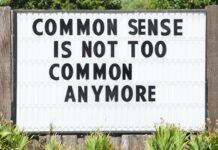NewsGuard, a service that rates adherence to basic principles of good journalism, gives my employer, Reason magazine, its highest possible score. Yet the Global Disinformation Index, a British organization that aims to steer advertisers away from disreputable websites, claims Reason is one of the 10 “riskiest” online news sources in the United States.
The stark contrast between those two assessments illustrates the challenge of defining “disinformation,” an increasingly nebulous concept that invites subjective judgments driven by political allegiances and policy preferences. That problem is especially acute when the government demands that websites take steps to curtail “disinformation,” portraying it as a grave threat to public health, democracy and national security.
The GDI, which receives financial support from the National Endowment for Democracy, purports to offer “neutral” estimates of the likelihood that a website will promote disinformation. Counterintuitively, its “risk” ratings do not require any actual examples of inaccurate reporting, let alone deliberate misrepresentations.
The GDI ratings are instead based on 16 “indicators” under two “pillars”: “content” and “operations.” The organization says Reason’s “high” risk rating was due to a lack of explicitly stated policies regarding “authorship attribution,” fact-checking, corrections, and moderation of reader comments.
The GDI emphasizes that its “content” judgments are based on a sample of articles that reviewers analyze without knowing the source or author, which it says helps “maintain nuance and neutrality.” But several of the “indicators” require judgments that are bound to be influenced by the reviewers’ personal opinions.
In assessing “article bias,” for example, reviewers are supposed to consider whether the writer uses “faulty logic” or “unfairly engages with different views on the story.” Reviewers also look for “negative targeting” of “individuals or institutions,” which is supposedly distinct from “criticism” based on “solid reasoning” and “strong evidence.”
The GDI says its ratings do not hinge on whether reviewers agree with the opinions that writers express. But it beggars belief to suppose that people who read articles that contradict their own views won’t be especially inclined to perceive “faulty logic,” insufficient attention to other perspectives, weak reasoning and inadequate evidence.
It is therefore not surprising that all 10 of the “riskiest” sources identified by the GDI are conservative or libertarian, while nearly all of the “lowest-risk” sites, which include NPR, The New York Times, HuffPost and BuzzFeed News, lean left. Although the GDI insists that “the index does not assess partisanship or the specific political, religious or ideological orientation of the site,” it explicitly considers “the degree to which the site is likely to adhere to an ideological affiliation.”
The GDI combines dubious methods with a dodgy definition of “disinformation.” You might think that disinformation, as distinct from misinformation, requires an intent to deceive.
But the organization disavows that requirement because it “cannot be directly measured.”
The GDI’s definition of disinformation nevertheless describes it as “intentionally misleading.” The organization contradicts itself again when it says “all newsrooms are vulnerable to disinformation risks, ranging from everyday human error to more nefarious tactics” (emphasis added).
You might also think disinformation, at the very least, must be false. The GDI thinks that criterion is also too demanding because it is “extremely difficult to assess at scale” and because “a statement that is technically true can be presented out of context in a misleading and harmful way.”
In short, the folks at the GDI know disinformation when they see it, although they do not claim that “high risk” websites actually promote it — only that they might. That attitude reflects a broader problem: Everyone agrees that disinformation is bad, but people disagree about what the category includes.
Given this confusion, the federal government’s efforts to squelch “disinformation,” which include pressure on social media platforms and subsidies for groups like the GDI, are especially chilling. Even “intentionally misleading” speech is protected by the First Amendment, and a government that respects freedom of speech has no business deciding how to apply that slippery label.































